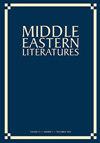Co-editors’ introduction
IF 0.2
4区 文学
0 LITERATURE
引用次数: 0
Abstract
The journal’s primary mission is to develop and expand networks of communication within and across relevant fields by publishing research that identifies the literatures and cultures of the Middle East not just as subjects of study, but as locations of knowledge with relevance beyond any one academic discipline or field of thought. In order to accomplish that radical goal we need the energetic participation of a large number of critical and creative thinkers, reviewers, and readers who are committed to establishing connections across geographies and time periods, forging theoretical languages grounded in the region’s epistemologies, and fostering a comparative literature beyond the main reference point of Euroamerica. We, in turn, are making an effort to reach new readers and authors, provide a forum for collaborative projects and special issues, and diversify our pool of peer reviewers. Despite the new vigor and diversity that we collectively bring to the journal, we continue to struggle to make room for the work and participation of scholars working outside of Europe and North America, especially those working in state-funded—or rather un-funded—institutions. A key challenge of the next phase in our journal’s history will be to address this decolonial challenge directly and to be frank about our failings and the structural reasons for them. In this, our first issue, we hope to demonstrate what this kind of work can look like. We are proud to be publishing three excellent and incisive articles by scholars whose research not only challenges existing paradigms, but pushes past them to suggest alternative vistas of analysis, comparison, and understanding. Two articles, “Eyes on the Prize: The Global Readability of an IPAF-Winning Modern Arabic Novel” by Anna Ziajka Stanton and “Orphanhood and Allegoresis in Radwā ʿĀshūr’s Thulāthiyyat Gharnātah” by M. J. Ernst, formulate new ways to think about the circulation of texts, literary aesthetics, and, in the case of the latter, experiences of imperial violence. Stanton puts forward alternative paradigms for thinking through translation and the circulation of texts between “center” and “periphery”, terms that have defined thinking about world literature over the past two decades. Ernst takes to task Frederic Jameson’s vision of Third-World literature as national allegory in the shadow of globalization, reading Radwā ʿĀshūr’s 1990s Thulāthiyyat Gharnātah (Granada Trilogy) as a “late capitalist allegory of the global South”, in which stories nestle within other stories as characters struggle to understand their place within a world of overlapping and联合主编的介绍
该杂志的主要使命是通过发表研究来发展和扩大相关领域内和跨领域的交流网络,这些研究不仅将中东的文学和文化视为研究主题,而且将其视为超越任何一门学科或思想领域的相关知识的所在地。为了实现这一激进的目标,我们需要大量具有批判性和创造性的思想家、评论家和读者的积极参与,他们致力于建立跨地域和跨时期的联系,锻造以该地区认识论为基础的理论语言,并培育超越欧美主要参考点的比较文学。反过来,我们也在努力接触新的读者和作者,为合作项目和特殊问题提供论坛,并使我们的同行审稿人多样化。尽管我们共同为期刊带来了新的活力和多样性,但我们仍在努力为欧洲和北美以外的学者的工作和参与腾出空间,特别是那些在国家资助或非资助机构工作的学者。我们期刊历史下一阶段的一个关键挑战将是直接应对这一非殖民化挑战,并坦率地面对我们的失败及其结构性原因。这是我们的第一期,我们希望展示这种工作的样子。我们很荣幸能够发表三篇优秀而深刻的学者文章,他们的研究不仅挑战了现有的范式,而且超越了它们,提出了分析、比较和理解的另一种前景。Anna Ziajka Stanton的《关注大奖:一部获得国际图联奖的现代阿拉伯小说的全球可读性》和M. J. Ernst的《拉德wal - Āshūr’s Thulāthiyyat Gharnātah》这两篇文章提出了思考文本流通、文学美学以及(在后者的情况下)帝国暴力经历的新方法。斯坦顿提出了翻译思维和文本在“中心”与“边缘”之间循环的替代范式,这些术语在过去二十年中定义了对世界文学的思考。恩斯特将弗雷德里克·詹姆逊(Frederic Jameson)对第三世界文学的看法视为全球化阴影下的国家寓言,并将拉德wna - Āshūr 1990年代的《格拉纳达三部曲》(Thulāthiyyat Gharnātah)视为“全球南方的晚期资本主义寓言”,其中故事相互交织,人物在一个重叠的世界中努力理解自己的位置
本文章由计算机程序翻译,如有差异,请以英文原文为准。
求助全文
约1分钟内获得全文
求助全文

 求助内容:
求助内容: 应助结果提醒方式:
应助结果提醒方式:


